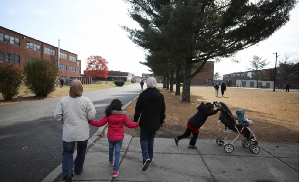A GNA Feature by Mohammed Nurudeen Issahaq
Bolgatanga, May 20, GNA - Traditionally, economic activity in the Upper East Region just as in the other two regions of the Northern Sector of the country, is centred on agriculture with about 80 per cent of the population engaged in crop farming.
For a very long time it has been small-scale subsistence farming except in the cases of rice and vegetable production. However, they all rely mainly on rains. Owing to climatic and environmental changes over time, it has become an accepted fact that rain-fed farming can no longer be relied on in the nation's quest for food security - the North being regarded as a major food growing area. The duration of rainfall in the area is increasingly getting shorter and its distribution unfavourable for any sustainable crop production.
Cognisant of this trend, successive governments with the support of external development partners came up with a number of interventions aimed at reducing the dependence on rain for agricultural purposes. In the case of the Upper East Region, the most prominent of such interventions has been the Land Conservation and Small-Holder Rehabilitation Project (LACOSREP) funded jointly by the International Fund for Agricultural Development (IFAD) headquartered in Rome, and the Ghana Government.
LACOSREP came in two phases with the singular focus on boosting agricultural production and reducing systematically the high levels of poverty in the Region. At the end of LACOSREP One (1991-1997) a total of 44 small-scale dams and dugouts had been rehabilitated, a few of them newly constructed, in various parts of the Region. Following the successful implementation of the project's first phase, its sponsors realized the need to consolidate the achievement with a follow-up, which became known as LACOSREP II. The implementation of the second phase of the project (1999-2005) saw the provision/rehabilitation of another 36 dams, bringing to 80 the total number of small-scale dams/dugouts brought to the Region under the Project.
To a large extent, LACOSREP has impacted positively on many communities in the Region, but has on the whole left many questions pertaining to sustainability unanswered. A report submitted to the IFAD Governing Council by an evaluation mission to the Region around 1999 led by Dr Zaki, a Former Sudanese Finance Minister and Consultant to IFAD, stated among other things that even though the Project had chalked many successes "there is still much to be done by way of poverty alleviation and household food security in a Region where the poverty level is rated to be the highest in the country."
Considering such factors as the drought-prone nature of the area and rapid population growth, there is a clear case for more dams in many more communities if irrigation farming should have the desired effect on the local economic environment and bring back the smiles on the faces of the people. At the same time, however, it would also be realistic to take a critical look at the entire hypothesis of dams as an automatic panacea to rural poverty.
Logically, given the area's geographical and environmental circumstances, an alternative source of water or irrigated farming for that matter, becomes imperative. But does the provision of dams in itself present a solution to the socio-economic problems confronting the people? So far, this has been the perception propounded by politicians and technocrats, and chorused at public functions by chiefs and opinion leaders in the rural communities. The reality, however, is that even though essential, dams are but a primary ingredients that require the support of other factors to become a successful tools for poverty reduction.
To check this assertion it might be pertinent to ask why in many communities in the Region where dams are sited the people still suffer abject poverty and high levels of unemployment. The adage that a raging fire outbreak cannot be extinguished with bare hands becomes very informative here. What significant benefit can be obtained if the people do not have what it takes, and if a conducive environment is not created, to enable them to utilize the dams profitably? In the absence of support factors such as the establishment of serious viable cooperative farmers' groups; effective monitoring/supervision; the provision of substantial credit facility to identifiable farmers associations to strengthen their productive capacities and with no adequate attention given to the crucial issue of sustainability, dams alone can hardly serve the purpose for which they have been provided.
During the implementation period of LACOSREP, residents in areas where dams existed were organized into Water User Associations to take charge of the dams. There was also a credit facility component attached to the project, under which loans were disbursed to farmers' groups. These were very laudable initiatives but their effectiveness began to wane with the phasing out of the Project, giving rise again to the twin issues of close monitoring and sustainability.
Close monitoring to ensure that loans given out for crop production were not diverted into other activities such as the purchase of textiles from Accra for sale in the Bolgatanga market, for instance. For sustainability, the generation of sufficient commitment and enthusiasm among stakeholders, coupled with the provision of the essential structures/logistics, are vital prerequisites.
Experiences over the years show that the issue of credit facility for agricultural production in the Region has been rather problematic mainly as a result of the non-payment of loans by farmers. In this regard, most observers are of the view that apart from the question of monitoring stated above, the meagre nature of the amounts disbursed to beneficiaries also constitutes part of the problem. Therefore, if this argument is anything to go by, then it would make sense to advocate a substantial increase in the loans advanced to farmers so that they would not regard such monies as 'chicken feed' or a gift meant to be squandered.
On the other side of the scale, modalities could be worked out for Government marketing agencies to purchase the produce at harvest, thus making it possible to deduct the loans at source when payments are being made to beneficiary farmers.
A close examination of the positive developments in dam communities at Tono in the Kassena-Nankana District and Bugre in the Garu-Tempane District bring out the fact that organization, supervision, focus and capital are the major driving forces needed to transform dams into effective agents of agricultural production and significant tools for poverty reduction.
With Tono, particularly, the role of the Irrigation Company of Upper Region (ICOUR) is an important example that should be replicated in other communities. Agricultural experts at ICOUR provide vital technical support and monitor the activities of the various stakeholders on the irrigation site to ensure the success of the scheme. Conversely, in most communities where dams have been constructed and left 'free for all', they only serve as ponds where cattle and other livestock go to drink water and to cool off. For those communities the absence of motivation and effective organization, have become major handicaps. In the particular circumstances of the Upper East there are three major constraints - timely land preparation, supply of inputs and market avenues. If these are adequately addressed in the rural communities where dams and well organised farmers' associations exist, the goal of food security on a sustainable basis can be achieved. Next door in Burkina Faso, the Bagre Dam Project, which this Writer was privileged to visit, offers a good example of the discipline, tenacity of purpose, and thoroughness in policy implementation for which the Burkinabe are well known. That facility alone is a major source of hydro-electricity, water for all-year-round crop cultivation, and fish-farming. Every farmer, every group leader, and every agricultural extension worker carries out what precise role is expected of them and the entire system rolls on smoothly, churning out hundreds of tones of fresh crops and vegetables worth many millions of CFA francs each year. Here in Ghana, we lack that tenacity of purpose when it comes to policy implementation. We come up with a brilliant policy, but become sloppy or lose focus in the course of implementation. Our history is replete with laudable ideas and plans we began with enthusiasm but which fizzled out mid-way because those in charge of ensuring their concretization either lacked commitment or were downright incompetent; or also because those in power did not offer the needed support and vigilance.
First-time visitors to Ouagadougou are amazed at the green environment there even though those parts are nearer the desert than Bolgatanga and Tamale, for instance.
Conscious of the fragile nature of their environment, the authorities in that country take tree-planting and environmental protection very seriously. No right-thinking Burkinabe would dare fell a tree or set a patch of vegetation ablaze because they know how dire the consequences would be when the law catches up with them. The point about these long Burkina tales is that we in Ghana need to sit up; shun lip-service and approach the performance of national tasks with all sincerity. Government should, as a matter of urgency, resolve to put an end to the ad-hoc and the stop-gap fashion in which policies are implemented in the country. Emphasis has to be placed on consistency, thoroughness and a dogged determination to obtain results, if we are to make significant progress.
Indisputably, irrigation farming holds the key to food security not only in the Upper East Region, but the entire nation. To derive the desired gains from these projects, however, calls for a shift in our present approach which is half-hearted and tends to take a lot of things for granted.
There is the particular need to inject some thoroughness into the way dams are constructed for irrigation purposes; the way farmers in the rural communities are organized; and how the entire usage of dams can be streamlined to derive maximum benefit from the investments made. We should depart from the assumption that just by providing dams in rural communities the poverty status of the people would be automatically ameliorated - even if we do not go the extra mile to ensure that the necessary conditions are created so that those dams can be put into profitable use.
Each year the Upper East Region experiences a glut in tomato production because there is no effective strategy to market the produce. This alone is an indication that given the same attention, focus and unity of purpose, bumper harvests of staples such as maize, millet, groundnuts and rice could also be recorded just like the tomato glut - and that is within the limits of possibility! Only then could it be said that maximum use is being made of irrigation dams in the area. Hopefully, some of the ideas articulated in this piece would be taken onboard during the implementation of the Northern Rural Growth Programme launched in Tamale recently by Vice President John Mahama, for the benefit of all.
So in the final analysis, is the provision of dams relevant to the area's economic development? Absolutely yes! However, this Writer proposes that before any further resources are committed to the construction of more dams in the Region, Government and the Ministry of Food and Agriculture should carry out impact-assessment exercises in communities where dams already exist to ascertain the extent to which those facilities have actually benefited the inhabitants in terms of poverty alleviation. This would not only expose the missing links for redress, but would also enable the Government to adopt a well-informed and more pragmatic approach to the whole issue of irrigation dams for all-year-round agricultural production. 20 May 09
Opinions of Wednesday, 20 May 2009
Columnist: GNA














